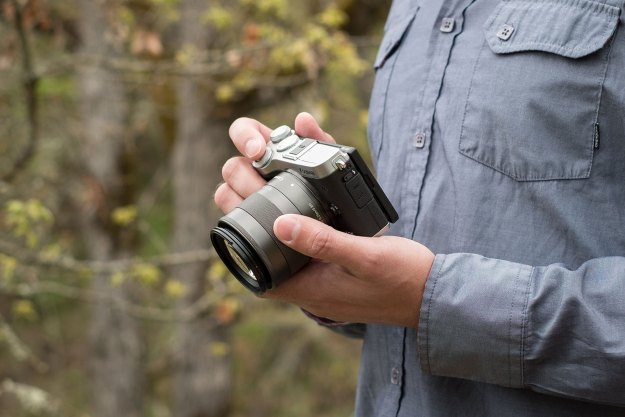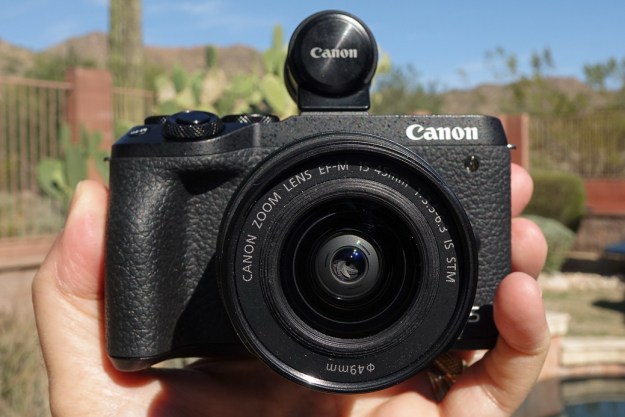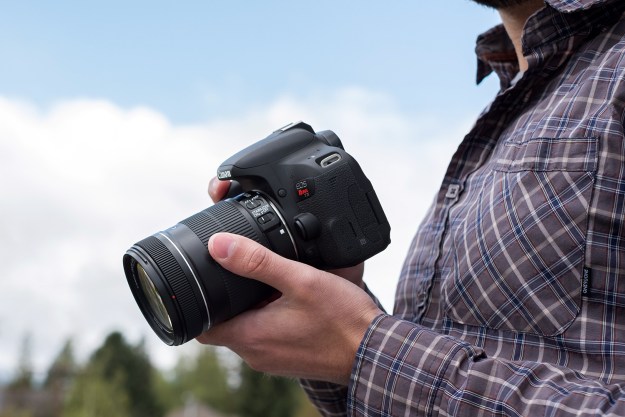
“The EOS M6 reaffirms Canon’s commitment to enthusiast-level mirrorless cameras.”
- Great build quality
- Enthusiast-friendly control layout
- Fast Dual Pixel AF
- Good still image quality
- Wi-Fi and Bluetooth connectivity
- No 4K video
- Digital stabilization lowers video quality
- Very limited lens ecosystem
- Optional EVF raises price above EOS M5
Last year’s EOS M5 marked a turning point for Canon. Up until then, the entrenched DSLR maker had a difficult time coming up with a recipe for a mirrorless camera that could win over enthusiast photographers. While the M5 lacked some features common to other models in its class, like 4K video, it nevertheless was a strong contender thanks to great autofocus performance, solid build quality, and an intelligent control layout and menu system.
So why are we going on about the M5 in a review for the new M6? Because the M6 is essentially a downscaled M5 without the electronic viewfinder. (The nomenclature is confusing: The M6 replaces the M3 – the M5 remains the flagship EOS M model.) This is great news for a couple of reasons. For one, any Canon fans who were intrigued by the M5 but couldn’t quite justify the expense, now have a lower-cost option for what is the same camera. The M6 starts at $780 for the body only, $200 below the M5, with kit options taking it up to $900 with the 15-45mm lens or $1,280 with the 18-150mm. Secondly, it signals to the industry that the M5 wasn’t a fluke and that Canon is ready to take mirrorless cameras seriously.
Engineered for enthusiasts
Like other Canons, the M6 puts function over form and includes plenty of features that should make photographers happy. Everything we liked about the M5 is still here. The camera feels great, with the same build quality and premium finish as the M5. Even the rubber grip feels particularly good, with just the right amount of friction, and likely represents the current pinnacle of rubber grip technology. Are we calling too much attention to a seemingly mundane detail? Maybe, but a camera that’s comfortable to hold is likely to get used much more than one that isn’t.
A few things have been rearranged compared to the M5 to respond to lack of an electronic viewfinder (EVF) on top of the camera. The pop-up flash has been moved to the left, forcing the mode dial back to the right and necessitating that one of the command dials be nestled beneath the exposure compensation dial. None of this negatively impacts the ergonomics of the camera and nearly all of the direct access control from the M5 is still there. None of the dials lock, but the mode and exposure compensation dials have ample resistance, so turning them by accident won’t be a problem.
For those who do want an EVF, Canon sells an add-on one for $250. Fortunately, street price is around $210, meaning the price of an M6 plus the EVF is just above the cost of an M5 (which has a built-in EVF). Customers who plan to purchase the EVF may therefore want to just go with the M5, although some may prefer to have a removable EVF to keep the camera as compact as possible when needed.
The M6 feels great, with the same build quality and premium finish as the M5.
The M6 is one of the best-made cameras in its class, but there are a couple of things we don’t like about its design. The plastic dial surrounding the four-way controller on the back of the camera is flimsy and considerably cheaper feeling than all of the other controls. There’s also the somewhat minor issue, shared by the M5, of not being able to access the battery and memory card compartment when a tripod plate is attached. D’oh.
But, what’s on the inside is what really counts, and the M6 contains the same 24-megapixel APS-C sensor as the M5 (which was trickled down from the EOS 80D), complete with Dual Pixel autofocus (DPAF). The Digic 7 processor also returns, giving the M6 the same ISO range of 100-25,600 and continuous shooting speed of seven frames per second (nine with focus locked).
The M6 also includes both Wi-Fi and Bluetooth for wireless image transfer to an iOS or Android device, and remote operation. As far as camera manufacturer apps go, Canon’s is one of the better ones (which wasn’t true not too long ago), and the setup process is fairly simple thanks to Bluetooth. The camera can connect over your local Wi-Fi network or form an ad hoc (peer to peer) connection straight to your mobile device.
Being that both cameras are so alike, the M6 also inherits the M5’s shortcomings. Video is limited to 1080p/60 and the five-axis electronic stabilization that’s available only in video mode simply doesn’t stack up to competing sensor-shift stabilization systems. Unless you really need it, we recommend leaving digital stabilization off; just use a stabilized lens and a steady hand for the best results.
The good news is that Canon’s DPAF technology is absolutely great in video mode. Face recognition and tracking works very well, but the Smooth Zone and single-point modes are also very useful. While the M6 may not be a filmmaker’s first choice, it simplifies video production for the novice, likely leading to better results than what entry-level users could get with a higher-quality camera with a steeper learning curve. Vloggers, YouTubers, and home movie creators will really appreciate the M6’s ease of use in video mode.
A capable camera with lackluster lenses
For as much as we want to praise the M6, we need to consider its many merits in context. The unfortunate reality is that the M6, like the M5, is a highly capable camera that lives within a very mediocre lens ecosystem. Canon has yet to introduce a single EF-M lens marketed toward enthusiasts, save perhaps the 22mm f/2 pancake – the one lens in the entire lineup with an aperture faster than f/3.5. There is no portrait prime, no constant aperture zoom, and no telephoto macro. Whereas mirrorless-only companies like Fujifilm and Olympus have focused on enthusiasts since the beginning (well, maybe not quite the beginning in Olympus’ case), Canon risks cannibalizing its own DSLR sales if the EOS M series does too well.
Digital stabilization in video mode simply doesn’t stack up to sensor-shift stabilization systems.
Interestingly, the M6 could still stand to draw customers away from Canon’s popular Rebel line of entry-level DSLRs. The new EOS Rebel T7i that we recently reviewed is an excellent camera and is built around the same sensor, but it’s bulkier, feels less well made, and doesn’t have as much direct access control as the M6. It also costs just $30 less. For the casual user, the compact M6 makes more sense, although there are certainly more lenses that can readily be used with the Rebel.
Sure, users can adapt EF and EF-S lenses to the EF-M mount, but this really only helps current Canon DSLR owners with an existing cache of lenses. Furthermore, those same lenses can be mounted to Sony mirrorless cameras with near full compatibility thanks to third-party adapters, so access to EF lenses isn’t even unique to the EOS M line.
In our testing, the sole lens we were provided was the 18-55mm f/3.5-5.6 IS STM (which, interestingly, is not one of the kit lens options with the M6). This lens is a bit of mixed bag. Well made, with good stabilization and silent autofocus, it won’t get in your way while shooting (at least in decent light). However, its poor sharpness betrays what the M6 is capable of. We know this 24MP sensor can produce good results, but without an equally good lens, many of those pixels are simply going to waste. A camera is only as good as its lens, a fact that many entry-level consumers may be OK to overlook, but this will definitely limit the M6’s appeal to enthusiasts.
Therefore, like we’ve done with other EOS M reviews, we have to conclude that the M6 only really makes sense for existing Canon DSLR users who want a familiar shooting experience in a smaller package with easy, first-party lens adaptability. This is a shame, because the M6 really is a decent camera that is only being held back by a lack of good glass. Given the much more established mirrorless ecosystems of other manufacturers, the M6 might be a hard sell for anyone who is not a Canon loyalist.
Warranty information
Canon offers a one-year limited warranty on the EOS M6.
Our Take
The M5 may have been a surprise, but the M6 confirms that Canon is committed to the enthusiast mirrorless segment – at least, in theory. While the lack of 4K video and sensor-shift stabilization is disappointing, there is very little not to like about the M6 when it comes to still photography, except for the rather dismal lens collection. Casual photographers may not mind this, but the M6 is clearly built with a more passionate user in mind. Anyone looking for a system they can grow into will be left wanting, at least for now. Hopefully, Canon will start churning out better glass in the near future, which will help make the M6 and the entire M-series more attractive.
Is there a better alternative?
There is certainly no shortage of options in this price range. We really like Panasonic’s Lumix GX85, which sells for around $700 (body only). It has been out for a while now, but offers 4K video, five-axis sensor-shift stabilization, and an excellent lens collection. The M6 boasts better potential image quality with its larger, higher resolution sensor, but it isn’t being fully realized by the current lineup of lenses.
How long will it last?
Again, the M6 is very well made. It isn’t weather sealed, so you’ll want to keep it dry – although, our test camera handled an onslaught of mist at the base of a waterfall without skipping a beat. In terms of durability, we expect it will have a very long life. As for how future-proof it is, it’s starting out already behind the competition with regard to video resolution and lens selection. The latter may improve with time, but there’s significant ground to make up.
Should you buy it?
If you’re a Canon DSLR shooter and want a more compact body that offers great control and a familiar experience, then yes. If you’re not already attached to a brand, the M6 isn’t a must buy. Casual photographers after an easy-to-use camera will likely be happy with it, but enthusiasts will very quickly outgrow the current lens options.
If this camera does appeal to you and you like having an onboard viewfinder, you should take a look at the M5. It costs less than an M6 plus the optional viewfinder.
Editors' Recommendations
- Lens teardown reveals how Canon made an affordable super-telephoto
- Should you buy the Canon EOS R5 or EOS R6? The new mirrorless options compared
- Nikon D780 vs Canon EOS 6D Mark II: The battle of budget full-frame DSLRs
- Canon EOS R5 is everything the R isn’t, thanks to stabilization, 8K, dual slots
- Canon EOS-1D X Mark III brings stunning stills and RAW video to an impressive DSLR















